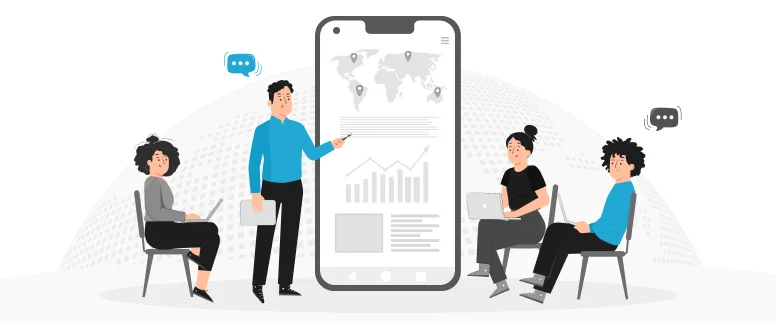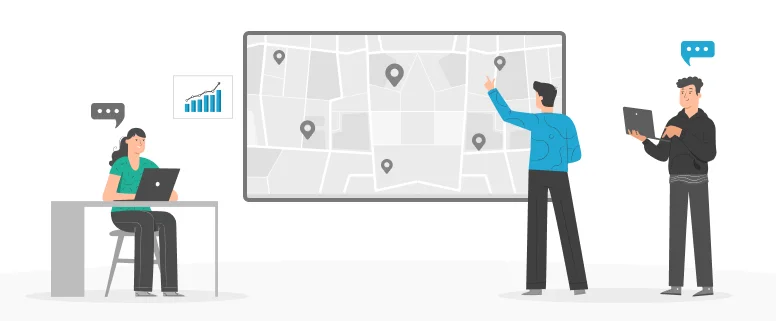Mobile app localization for diverse markets is an intricate process that requires in-depth market research and close attention to UX design and language.
From online airplane ticket bookings and hotel reservations to e-learning apps for kids and daily calorie tracking, we have a bunch of apps on our smartphones that add value and convenience to our everyday lives. Because of the high user demand for all sorts of apps used for entertainment, education, travel, and security purposes, mobile app development has become a lucrative business globally.
However, it gets challenging to handle your app localization effectively, considering linguistic, design, quality, technical, and executional aspects of it. In this article, we’ll meticulously look into all four stages of mobile app localization and the best practices that localization managers can use to get the best outcomes.
Table of Content
- Why Does Mobile App Localization Matter?
- 3 Major Complications of Localizing Your Mobile App
- Major Complications of Localizing Your Mobile App
- 4 Stages of Mobile App Localization: From Planning to Scaling in Global Markets
- Stage 2: Translations and UX Design
- Glossaries Preparation
- Textual Content Translations
- Cultural Adaptations
- UI/UX Design Modifications
- App Accessibility Considerations
- Stage 3: Quality Assessment and Improvements
- Stage 4: Final Delivery & Promotions
Why Does Mobile App Localization Matter?
With the increased use of smartphones, the mobile app market is continuously expanding. Even in developing countries, you can see people have mobiles in their hands with an internet connection.
Mobile app localization enhances your app’s reach to all English-speaking and non-English-speaking audiences. It not just enhances your app’s user experience but also gives you an edge over competitors who target only an English-speaking audience.
The real challenge for app development companies is to get more app downloads to maximize their revenues. So, if you’re not localizing your app for local markets, you’re missing out on a huge chunk of potential users.
3 Major Complications of Localizing Your Mobile App
It May Slower Time to Market
You have to spend a considerable amount of time on mobile app localization, from the development of a localization strategy for each region to app store optimization. You need to coordinate with localization teams and deal with other language and culture nuances throughout the process. It significantly extends your time to market your app in a particular market.
Moreover, regulatory-compliance is another challenge that mobile app developers have to deal with because every country has its own laws and legislation. So, it is critical to keep the mobile app localization process agile to avoid delaying release timelines, and it can negatively impact your ROI.
There Will Be Translation Quality Issues
Keeping the translation consistent, accurate, precise, and culturally appropriate is the biggest challenge of app localization. Especially when you are targeting multiple regions at the same time. Translations with linguistic, logical, and cultural errors can have an adverse impact on your user experience. Similarly, it is crucial to maintain a consistent brand voice, terminology, and style in all markets.
Translating your app may appear as a simple process of altering the language of your app, but it is more complicated than you think. You may have heard examples of many big brands making reckless translation mistakes, like KFC. So, you better contact a reliable mobile app localization service provider that follows a proper translation quality assurance process.
App Localization ROI Is Hard to Measure
It is complicated to measure the impact of localization efforts on overall mobile app revenue. Unlike traditional marketing campaigns, the results of your mobile app localization cannot be seen immediately. You need to meticulously analyze the incremental value generated by the localized version of the app in comparison with the original app through attribution modeling and data analytics.
Moreover, there are many other factors, like the competitive landscape, market dynamics, and user preferences, that can influence the overall performance of a mobile app. So, in order to evaluate the app localization ROI, you need a comprehensive assessment of both qualitative and quantitative metrics over an extended period of time.
4 Stages of Mobile App Localization: From Planning to Scaling in Global Markets
To make your mobile app successful in a foreign marketplace, you have to effectively go about all of its localization phases, from the development of a localization strategy to promotions in a foreign market. Here are the four major stages of mobile app localization, along with all the necessary steps that one must follow to ensure high quality results.
Stage 1: Research and Panning
Identifying Potential Markets and Languages
Targeting the right market to launch your mobile app is critical to ensure a quick and profitable ROI. For this, you must study the market thoroughly to look for any potential for your mobile app to scale. Every market has its unique demographics, languages, and cultures, so you have to adapt your mobile app considering these factors.
Competitors Assessment
When you evaluate competition in the market, it not just allows you to analyze how much room is there for you to scale, but it may also give you some idea about what will work in a particular market and what will not. By learning from the mistakes and successes of your competitors, you can develop a better expansion strategy and localize your app more effectively.
Content Audit and Preparation
Before strategizing your app localization, you must have some idea of what needs to be done and how you will execute the localization plan to get the expected outcomes. You need to make a comprehensive content audit to identify all elements that require localization, including textual content, images, and design. At this stage, you may also prepare your content ready to be localized. For instance, if you separate your text strings from the code for translations, it will help streamline the translation process and make the localization hassle-free.
Resource Assessment and Allocation
Your localization strategy will very much depend on what resources and tools are available to you and the budget allocation for the overall localization project. It is the time when you must evaluate your localization needs and make up your mind what you really need to invest in. Is it more convenient for you to outsource mobile app localization services, or does hiring an in-house team of localization experts seem feasible? So, considering your localization budget, you must invest in the right tools and technologies.
Localization Strategy & Execution System
Once you know your markets, competition, requirements, and budget, it’s time to come up with a solid localization strategy. Your mobile app localization plan must clearly outline the objectives, execution method, timelines, budget, resource allocation, KPIs, and risk management plan. Your localization strategy has to be flexible. So, if there is any change in circumstances or unexpected challenges arrive, you can adapt your strategy and adjust the processes accordingly.
Stage 2: Translations and UX Design
Glossaries Preparation
Before translating your app’s content, you must prepare glossaries to ensure that your translations will remain consistent across all regions. When you create glossaries of brand terminologies and definitions, they will serve as reference material for your translators. Glossaries may also specify preferred translations for industry specific terms and other linguistic instructions for linguists. This way, you’ll be able to achieve translation consistency and keep your brand tone unchanged in all mobile app versions.
Textual Content Translations
Local language translations are at the core of your localization project because they allow the user to easily access the app and comprehend its content effectively. Depending on the number of markets you are targeting, you will be translating your app into multiple languages. You must hire native translators with good language fluency and cultural understanding to translate your mobile app. Translators must maintain a high level of precision and clarity while translating UI elements such as buttons, CTAs, menus, and dialog boxes.
Cultural Adaptations
You have to make your mobile app resonate with target users from diverse regions and cultures. Other than translating textual content, it involves adapting the designs, layouts, themes, and formatting of your app for local users. For instance, for the Japanese market, you must translate your app considering Japanese communication styles, and be very careful while adapting humor, idioms, and other emotional expressions. Similarly, for designs, you must go for aesthetics and symbolism that reflect Japanese culture and avoid using any imagery that can cause offense to your target users.
UI/ UX Design Modifications
Your mobile app UI should be responsive and seamlessly adapt to different device sizes and resolutions. You must build your app on Unicode principles. So, all design changes can be easily implemented without affecting the app’s core functionalities. When your UI layouts are flexible, they can easily accommodate text contraction and expansion without overlapping with design elements. Also, make sure that the navigation patterns and controls are familiar to users in your target markets. It will enhance your mobile app’s utility and ease for users.
App Accessibility Considerations
The major purpose of doing localization is to improve your app’s accessibility for potential users. For instance, if your app supports multiple languages and writing styles, it’ll be accessible to more users from diverse backgrounds. Here are a few examples of what an accessible mobile app looks like:
- Provides text alternatives for non-textual content.
- Ensures keyword accessibility.
- Provides audio feedback and alerts.
- Uses simple and clear language.
Stage 3: Quality Assessment and Improvements
Language Accuracy & Consistency Review
Maintaining the translation quality while managing multiple versions of the app is not an easy nut to crack. You must have established a robust quality assurance system. Make sure you are selecting experienced editors, proofreaders, and subject-matter experts to evaluate the quality and relevance of translated content for the mobile app. You must provide clear proofreading guidelines to reviewers, including expectations, tone, formality, style, and unique terminologies. You can go with both manual and automated QA testing to make the localization process more agile and effective.
Functional & Design Testing
It is important to test your app post-localization to ensure that it is fully functional and usable. When you are localizing your mobile app and dealing with multiple versions simultaneously, there are chances of functional and technical issues that need to be fixed. So, you must check your mobile app for the following:
- All translations are well aligned with UI design elements.
- Navigation and UI elements are functioning properly.
- There is positive feedback from target users on localized app versions.
- Localized apps are compatible with different devices, operating systems, and screen sizes.
- The localized app is performing optimally for all languages and UI design versions.
- All versions of the app are accessible to users with disabilities.
Bug Fixing and Error Resolution
There are chances that you will find some errors and performance issues in your app after localization. It’s time to fix them. However, you need a system in place for agile error fixing, so you’re not further delaying your time to market. You can use an automated testing tool combined with some expert inspection to make this process quick and efficient.
Prioritize the fixing of localization errors based on their severity and impact on the app experience. For instance, if there is anything mistranslated, or UI elements are colliding with each other, these are critical issues that must be resolved on priority.
User Feedback Integration
You are lucky if you are able to make a perfect version of your localized app in just one go. Localization is a process of continuous improvement, and for this, you need a structured approach to gather, analyze, and implement user feedback.
First, you should collect feedback from your target users. There are some common ways you can gather user feedback.
- Implement a feedback mechanism on your mobile app.
- Create feedback forums and rating prompts.
- Conduct in-app surveys.
- Social media interactions.
Once you have collected the feedback using any of the above methods, you need to analyze your feedback data. You can evaluate feedback patterns and common issues faced by users to identify users’ pain points.
As you have figured out areas for improvement, you can create an actionable plan and engage with experts to implement new localization updates. In the end, you’ll evaluate the impact of your updates on user engagement and overall retention metrics. If the results are positive, it’s the right time to plan the launch of your mobile app with full-fledged marketing in the target market.
Stage 4: Final Delivery & Promotions
App Store Optimization (ASO)
Your localized mobile app is all set to be launched, you’ll have to submit it to your app store. However, here are some key considerations:
Metadata localization
Firstly, you need to localize your app title and description for every region in the local language. It will enhance your app’s visibility and eliminate the language constraint.
Localized screenshots and images
All the graphics and visual assets you are uploading with your app details should be localized, and make sure the screenshots are from the localized app version.
Keyword optimization
You must optimize your app for locally relevant keywords and phrases to improve its rankings and searchability. Also, try to naturally incorporate some keywords into your metadata.
Adapting Promotional Material
Just like your app, you must localize your promotional and marketing material to local preferences. It includes translating your social media posts, emails, press releases, and advertisement campaigns into local languages. Similarly, the right use of imagery and colors is also significant to get more eyeballs and make your app look more appealing to local users in any country.
For each market, you have to be mindful about tailoring your messaging to local sensibilities without compromising your original tone. Similarly, for your target market, you may need to tailor your promotional channels considering where your target audience spends the most time online.
Localized Customer Support
Considering the complexity of your app, your users will need some assistance with comprehending the features and a guide to using it. Your users may face technical issues navigating the app or enabling its functionalities, so you must provide 24/7 customer support to them in their local language. You can provide support through email, live chat, or a phone call. Make sure your customer support representatives are fluent in the local user language and accommodate them in the best way possible.
It will be even better if you can provide culture-sensitivity training to all of your customer support staff that will help them effectively address customer issues.
Continuous Performance Monitoring and Optimization
You have launched the localized app successfully; however, the work is not done yet. You must continuously keep an eye on your users’ engagement with the app, their feedback, and the most common issues they are facing using the app. At this final stage, you monitor the ongoing performance of a localized app in a market and implement improvements and updates.
Make sure you have established clear KPIs and have an advanced analytics tool to track your user interactions and app usage patterns. This data will be very helpful in optimizing your localized mobile app experience for users in diverse markets globally.
Conclusion
This article talks about the significance and challenges of mobile app localization and the best ways to approach a localization plan. We have discussed four stages of app localization in detail, from market research to promoting your app in foreign regions. Make sure you check all the points mentioned in the article to maximize the impact of your app on a foreign market and structure an agile system that supports continuous app localization.



